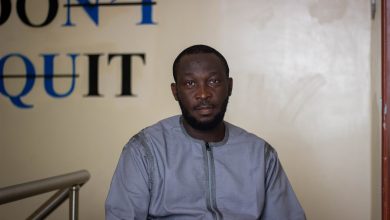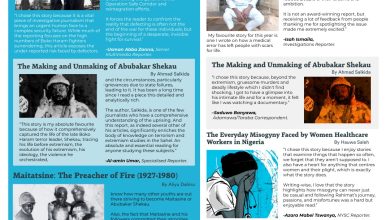
Violent extremist groups loyal to the Islamic State take the education of their young ones seriously, and they fashion it in a way that encourages blind loyalty and prepares them for a life of combat.
Several pictures and videos released by the Islamic State West Africa Province (ISWAP) show young members either in military training camps or in classes receiving lessons. In one of the videos seen by HumAngle, an instructor was shown teaching Arabic grammar to children seated on benches.
Apart from that, little was known about what the insurgents teach their children, particularly in Nigeria and Lake Chad, as ISWAP rarely shows children in its propaganda releases. However, as a province of the Islamic State in Iraq and Syria, the group uses the same basic education curriculum designed by IS-Central.
The school curriculum has been in existence since 2010 but was fully implemented between 2014 and 2017 when the jihadists announced their caliphate in Iraq and Syria. However, they recently revised and redistributed it in May 2024, using their propaganda channels to distribute it across affiliate groups worldwide.
The curriculum is for the kindergarten, primary, and secondary schools. The kindergarten section consists of only one class, the primary school has five classes, and the junior and senior secondary schools have two and three classes each.
The subjects include religious ones such as Hadith, Sharia Politics (Siyasa-shar’iyya), Quran and its Exegesis, and so on. There are also scientific subjects such as Biology, Chemistry, Geography, Mathematics, and Physics. The curriculum also has a combat training manual for the instructors.
The books are full of pictures of fighters and illustrations showing the flags of ISIS and weapons such as bullets, guns, jets, rocket-propelled grandes (RPGs), and rockets. This is to familiarise the children with weapons at a young age so they’ll grow up using them with mastery.

The extremist group produces and distributes these learning materials, including textbooks and workbooks, that are filled with propaganda glorifying martyrdom and demonising the group’s enemies. The PDF versions are available in its private groups and website (which is now inaccessible).
By controlling the content and context of education, extremist groups ensure that every aspect of a child’s learning experience reinforces their ideology.
Extremist doctrines
Central to the Islamic State curriculum is an extremist Salafi-Jihadi doctrine. While traditional Islamic education emphasises values such as justice for all and respect for human life, the jihadist curriculum twists these teachings to justify violence and hatred against those they consider infidels or enemies of their version of Islam.
The textbooks instruct children that fighting and killing for their cause is a religious duty. They emphasise the classical dichotomy between the “abode of Islam,” referring to where the insurgents constitute a caliphate, and the “abode of Kufr,” where the rest of the people live, particularly where democracy or any other system of government is practised. While peace is ideally maintained in the former region, the latter is expected to be engaged in a constant war.
For instance, a primary school student’s “Siyasa-shar’iyya” (Shari’a Politics) subject justifies attacking any Muslim who does not practise Sharia. By this, they mean any system that’s not based on Islam, such as democracy, should be violently fought. To back their arguments, they used the fatwa of Ibn Taimiyya, a 13th-century theologian, in which he justified war against the Mongols because, despite converting to Islam, they refused to adopt the Sharia law in favour of their constitution – The Yassa.

They also encourage memorisation of selected Quranic verses and hadiths (sayings of the Prophet Muhammad) that are interpreted to support violent jihad. For example, in another textbook on Sharia politics for primary one students, the cover page of the book came with a saying attributed to the Prophet Muhammad that whoever dies without paying allegiance to a leader (in this case, the IS caliph) has died like a wanton person.
The extremist ideologies present these teachings as the only true form of Islam, thereby isolating children from more moderate or traditional interpretations. This isolation reinforces the group’s control over their minds and discourages critical thinking or exposure to alternative viewpoints.
Beyond that, the curriculum’s teaching is similar to the basic mainstream Salafi doctrines. The books, especially those meant for secondary school students, are filled with the sayings of classical Muslim scholars, especially those who are frequently quoted by Salafi-Jihadi ideologues such as Ibn Taimiyya, Ibn Qayyem, and Ibn Hanbal.
Militarisation of education
In addition to religious indoctrination, the curriculum places a heavy emphasis on military training through a subject they call iidadil badani (preparing the body). An instructor is given a training manual to guide sporting activities such as wrestling, acrobatics, and boxing.
From a young age, children in this system are exposed to weapons and trained in their use. This militarisation of education is not just about preparing children for combat; it is also about desensitising them to violence and normalising the use of force to achieve their goals.

The books’ pictures and illustrations show children undergoing rigorous physical training, learning to handle firearms, and participating in mock combat exercises.
Some books for young children feature pictures of weapons such as guns, bullets, bombs, and swords—even the mathematics textbook, where some counting is based on pictures of the weapons. This is the same for English texts, where there are blurred pictures of bombings on the cover and those of children in combat or holding guns.

Research has shown that, apart from what is in the textbooks, children are forced to watch videos of executions or to practise the execution themselves. Videos seen by HumAngle show how children, apparently as young as 10, are given weapons to kill or slaughter a victim. The children are taught to suppress their emotions and to view brutality as a normal and even commendable religious duty.
The psychological impact of such an education is profound and long-lasting. The violence they witness and participate in often traumatises children growing up in this environment. Moreover, it can severely impair a child’s ability to form healthy relationships and to function in a peaceful society if they ever leave the extremist environment. Reports have shown how rescued children in northeast Nigeria continue to display hatred towards the military and hold onto some extremist views.

Subjects and learning materials
The extremist curriculum primarily focuses on religious and military education, but it also teaches other subjects through a lens that reinforces the group’s ideologies. They manipulate subjects like mathematics, science, and history to fit their narrative.
For example, mathematics lessons include calculating distances for launching attacks and counting weapons. Science lessons include the mechanics of weaponry and the chemistry of explosives. History is often taught in a way that glorifies the classical conquests in Islam’s history and frames ISIS’s actions as a continuation of a noble struggle.
The jihadi curriculum has eliminated any content that contradicts their beliefs. In the biology textbook, the Darwinian theory of evolution was removed and replaced with literalist creationism. In geography, everything is attributed to God, and scientific explanations are backed by religious texts and described as scientific miracles (i’ijaz ilmi).
Other subjects that do not conflict with their ideology, such as chemistry, are taught plainly.
Gender in extremist education
Gender roles within the extremist curriculum are strictly defined and reinforced from an early age. The curriculum grooms boys to become fighters while it trains girls to support the group in other ways, like becoming wives and mothers who will raise the next generation of jihadists.
Girls’ education within this framework is limited, focusing on domestic skills and religious instruction that reinforces their subservient status. This not only perpetuates gender inequality but also ensures that women remain within the control of the group, unable to seek independence or alternative perspectives.
The textbooks teach the same courses differently to the segregated classes. The books indicate that one is meant for boys and the other for girls. For example, on Sharia Jurisprudence (Fiqh Us-Sharia), the one for boys was written, and it focuses on leadership, war, and paying allegiance. While the ones for girls also focus on leadership, the emphasis on combat is limited.
Support Our Journalism
There are millions of ordinary people affected by conflict in Africa whose stories are missing in the mainstream media. HumAngle is determined to tell those challenging and under-reported stories, hoping that the people impacted by these conflicts will find the safety and security they deserve.
To ensure that we continue to provide public service coverage, we have a small favour to ask you. We want you to be part of our journalistic endeavour by contributing a token to us.
Your donation will further promote a robust, free, and independent media.
Donate HereStay Closer To The Stories That Matter




